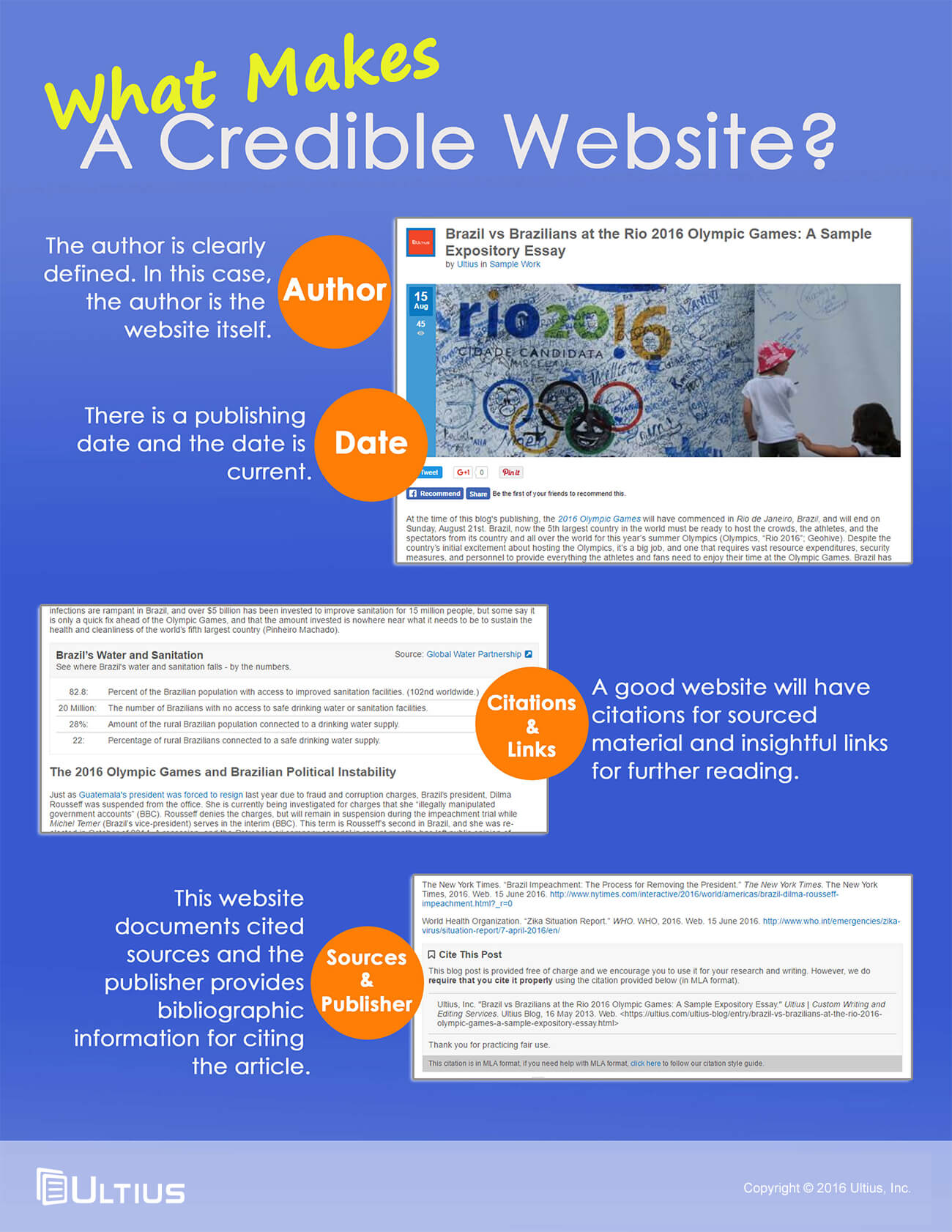Infographic: What Makes a Credible Website Source?
January 8, 2017 Writing Help
Full description. Credible sources are a key component of any good essay or research paper. Before the internet, you could reliably pick and choose a book from a local library and know with a high level of certainty that it is credible. After all, who would take the time to publish a book or article with inaccurate or wrong information? But since the internet became mainstream, anyone with a keyboard and mouse has the ability to publish content online. That's why it's up to you to know how to carefully evaluate the credibility of online sources.
What's included. This brief infographic showcases some simple steps you can take to ensure that the website you are citing is a credible source. Just follow the analysis steps provided and you can be confident that you won't lose points (or even a letter grade) for using poor online sources.
- Trust but verify: This slogan is not only useful for life, but online research as well. By default, (mostly) anything published in a library or an online journal database (like Sci-Hub) is going to be a good choice. But when you are looking at websites, the authorship and credibility is not always clear. Follow the steps below to see if the website is useful or a dud.
- 1. Authorship (critical): The authorship of the website (and preferably the specific page) must be clearly defined. Look for citations or authorship notes at the beginning or end of the website page to find it.
- 2. Timestamp (preferred): There should be a date of publication located where you found the authorship information. If not, it doesn't discount the source completely, but you should be wary.
- 3. Citations and links (critical): Almost all credible online sources (like the posts on the Ultius blog or this infographic) will have proper attribution for the information they referenced. Think about how CNN or Forbes articles generally have links to the original source of the information. Even novel concepts and ideas like Einstein's relativity theory referenced the body of work from other scholars to set a foundation. Look for links under sections that reference "further reading" or "works cited."
- 4. Bibliographic information (preferred): Most scholarly articles will provide you with a reference list of sources. These are usually found at the bottom of the article or in-text if they used a citation style like APA format. Most websites don't follow strict formatting styles, so you should look for a list of links or references at the bottom or the side of the page.
- 6. Final considerations: Finally, it's a good idea to click around the site and see if it's designed well, attributed to a credible organization and/or useful for other information. Avoid personal blogs (in most cases) and ask a friend or professor if you are really unsure, but need the information. Alternatively, you can try and find the same information from another source that is credible.
If you follow the steps above, you can be confident that you are using appropriate sources for your research paper or dissertation writing project.
- MLA Style
- APA Style
- Chicago Style
- Turabian
Ultius, Inc. “Infographic: What Makes a Credible Website Source?.” Free Resources and Research Materials | Ultius, 08 Jan. 2017. Web. https://ults.co/7iRqLYq.
Copied to clipboard
Click here for more help with MLA citations.
Ultius, Inc. (2017, January 8). Infographic: What Makes a Credible Website Source?. Retrieved from Free Resources and Research Materials | Ultius, https://ults.co/7iRqLYq
Copied to clipboard
Click here for more help with APA citations.
Ultius, Inc. "Infographic: What Makes a Credible Website Source?." Free Resources and Research Materials | Ultius. January 8, 2017. https://ults.co/7iRqLYq.
Copied to clipboard
Click here for more help with CMS citations.
Ultius, Inc. "Infographic: What Makes a Credible Website Source?." Free Resources and Research Materials | Ultius. January 8, 2017. https://ults.co/7iRqLYq.
Copied to clipboard
Click here for more help with Turabian citations.

Related Infographics
-
 Comparing Google Docs and Microsoft Word [Infographic]
Comparing Google Docs and Microsoft Word [Infographic]
8 Jan. 2017
-
 Ten Dissertation Writing Tips and Tricks [Infographic]
Ten Dissertation Writing Tips and Tricks [Infographic]
12 Dec. 2016
Related blog posts
-
 Must-Have Technology for Graduate and Doctoral Students
Must-Have Technology for Graduate and Doctoral Students
21 Apr. 2016
-
 Top 10 Study Apps for College Students
Top 10 Study Apps for College Students
24 Feb. 2015
-
 Comparing EasyBib vs. EndNote for Citations
Comparing EasyBib vs. EndNote for Citations
22 Aug. 2016
-
 Free Online Databases and Resources for Writers
Free Online Databases and Resources for Writers
20 Aug. 2015
-
 Six Ways Reading Makes You a Better Writer
Six Ways Reading Makes You a Better Writer
24 Sep. 2016
-
 Improve Your Writing With Six Proven Ways
Improve Your Writing With Six Proven Ways
2 Aug. 2016
Related Guides
-
 Evaluating Sources for Research Papers
Evaluating Sources for Research Papers
How-to guide
-
 Doing Proper Research for Essays
Doing Proper Research for Essays
How-to guide
About the author
Ultius is a technology platform that connects consumers with American freelance writers. With 2,000+ writers and customers in over 45 countries, Ultius is a global leader when it comes to matching you with an expert writer in any field.
Learn more